05 April 2023
Happy Birthday RAF: Commemorating Royal Air Force personnel 105 years on from the founding
The 1st of April 2023 saw the RAF celebrate its 105th birthday. Discover some of the stories of the men and women we commemorate from this illustrious organisation.
RAF 105th Anniversary
When and why was the Royal Air Force formed?
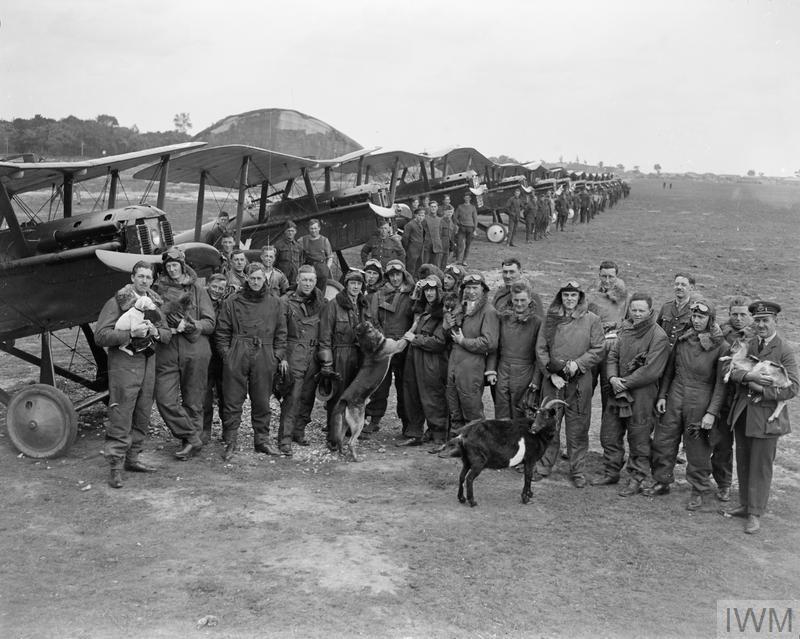
Officers of No.85 Squadron, RAF, France 1918 (© IWM Q 12049)
The Royal Air Force was founded on 1st April 1918.
However, instead of being a brand new, freshly minted organisation, the RAF grew out of two pre-existing formations: The Royal Flying Corps (RFC) and the Royal Navy Air Service (RNAS).
The RFC was established in 1912. British military planners realised the potential of an aerial combat wing early on, despite aviation being very much in its nascent phase.
The RFC fell under British Army control. Likewise, as its name suggests, the Royal Navy Air Service fell under the auspices of the Royal Navy, controlled by the Admiralty.
World War One was the crucible in which modern military aviation was formed. As the war went on, the role of aircraft expanded greatly, and their strategic and tactical combat potential grew and grew.
South African Field Marshal Jan Smuts advocated for a separate air force in the Smuts Report, presented to the Imperial War Cabinet in August 1917.
Smuts’ findings chimed with contemporary military thinking and thus the decision was made to amalgamate the RFC and RNAS into the RAF.
Alongside the RAF, the Women’s Royal Air Force was also established in April 1918. Its original plan was to train female mechanics to free up men for the war effort.
Enrolment far exceeded expectations. Soon women were serving in a variety of important non-combat roles, including drivers, caterers, clerks, tailors, and other important jobs for the war effort.
Commonwealth Air Forces
Commonwealth nations fighting under the umbrella of the British Empire also established their own air forces.
The Canadian Air Force, a small two-squadron unit, the Australian Flying Corps and South African Air Corps represented dedicated Dominion Great War air services. Otherwise, pilots from around the world either served in the RFC, RAF, or RNAS.
Following the conclusion of World War One, each Dominion formed its own, dedicated air forces, independent of the Royal Air Force. These included:
- Royal Australian Air Force
- Royal New Zealand Air Force
- Royal Indian Air Force
- Royal Canadian Air Force
- Royal South African Air Force
These organisations also formed the basis for each nation’s independent present-day air forces.
Royal Air Force in World War One
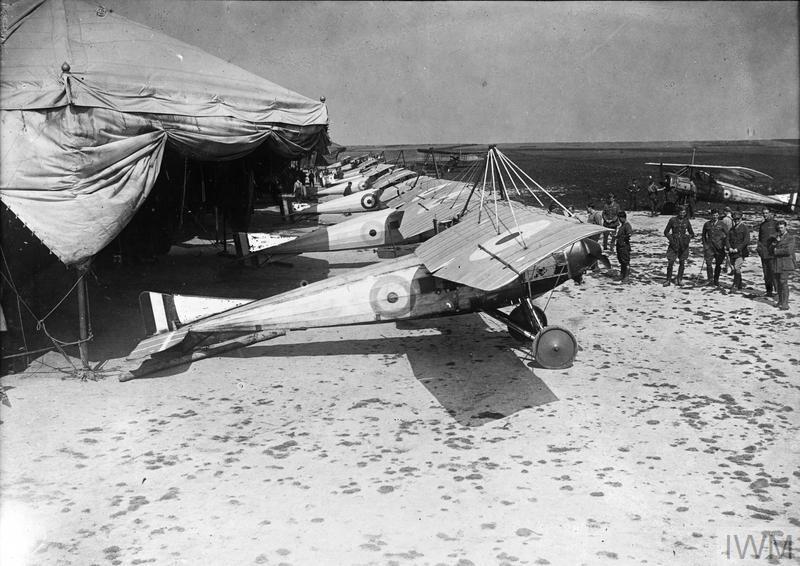
Morane parasol biplanes of No. 3 Squadron RFC at La Houssoye, September 1917 (© IWM Q 11844)
At the time of its founding, the Royal Air Force was the largest organisation of its type in the world. It was also considered the most powerful military aviation unit in combat.
Including the Women’s Royal Air Force, over 300,000 personnel served in the Royal Air Force or air services in World War One. The unit was operating 20,000 aircraft of various types.
Considering just 66 Royal Flying Corps pilots had joined the British Expeditionary Force in 1914 on its first journey to the Western Front, the RAF’s growth during wartime was staggering.
The major aerial engagements over the Western Front were fought by the Royal Flying Corps until it evolved into the RAF.
The Battle of the Somme in 1916 proved a baptism of fire for British military aviators. Pilots provided tens of thousands of reconnaissance photographs and began to coordinate with ground forces for the first time in earnest.
Aircraft could spot artillery positions, scout enemy trench networks, and provide a bird’s eye view of battlefields. This information could be passed on to Army units for better planning.
Of course, aircraft played an offensive role too. Fighter pilots clashed in terrific dogfights over the Western Front. Bombers also targeted trench networks and enemy formations.
Massed British aerial formations clashed with their German counterparts over the Somme in 1916, resulting in the deaths of 250 RFC pilots.
Perhaps the most infamous episode of the war for British and Commonwealth pilots was Bloody April in 1917.
Bloody April formed part of the Arras Offensive. While the RFC heavily outnumbered its German opponents, their aircraft and tactics were obsolete. German pilots, including the feared Red Baron, scored many victories.
By the end of April, the RFC had lost 250 aircraft and around 400 personnel.
Still, victories would come. The Air Battle of Saint-Mihiel in September 1918 was the largest air battle of the war to which the RAF provided 9 bomber squadrons.
Elsewhere, the RAF and Dominion air forces fought with distinction. The Australian Air Corps, for example, was present at the Capture of Jericho in the Middle East. The South African Air Corps also played an important role in the battles in South and German West Africa.
Flying Aces
The concept of flying aces was established during World War One.
The term was first coined by French newspapers to describe pilot Adolphe Pégoud aka l’as (“the ace”). Pégoud had shot down five German aircraft, eventually six, before his death in August 1915.
Five aerial victories, i.e., forcing an enemy aircraft to land or shooting one down, became the number needed to become an ace.
Aces were important propaganda tools on both sides. Their skyward exploits made them famous, giving a human element to a highly mechanised part of warfare, and giving ordinary civilians heroes.
German pilot Baron von Richthofen was probably the most famous ace of the war, but the Allies had many such pilots like the American Eddie Rickenbacker or British pilot and Victoria Cross winner Albert Ball.
RAF Great War casualties
By the end of the war, more than 6,000 men and women of the air services had been killed.
Powered flight was already a new area of exploration for mankind during the Great War. Add in the incredible hazards of combat, flying was exceptionally dangerous.
Accidents as well as combat could prove deadly. For instance, Victoria Cross-winner and Britain’s second-highest scoring ace of the war, James McCudden, was killed in a flying accident on 9th July 1918.
Major Edward "Mick" Mannock VC
 Image: Major Edward "Mick" Mannock and his dog (Wikimedia Commons)
Image: Major Edward "Mick" Mannock and his dog (Wikimedia Commons)
Edward “Mick” Mannock walked an eventful path before he became Britain’s highest-scoring World War One fighter ace.
At the outbreak of the war, Mick was working as a telephone engineer in Turkey, then part of the Ottoman Empire. His erstwhile hosts were soon in opposition to the British Empire and Mick was quickly thrown in prison.
Mick suffered appallingly at the hands of his Ottoman gaolers. He suffered from malnutrition and contracted malaria.
Believing he was too weak to serve the war effort, Ottoman authorities deported Mick back to England in 1915. How wrong they would be.
Mick quickly enlisted in the Royal Army Medical Corps upon convalescence but soon found himself at odds with his comrades. A transfer to the Royal Engineers soon followed, but this was not enough to satiate Mick.
A friend suggested Mick join the Royal Flying Corps, the organisation that would evolve into the Royal Air Force.
Apparently, Mick was a natural airman. He acquired his Royal Aero Club certificate in November 1916 and passed his aerial gunnery, aircraft rigging, map reading, and flight theory courses with flying colours.
One of his flight instructors, Captain Chapman, said: “He made his first solo flight with but a few hours’ instruction, for he seemed to master the rudiments of flying with his first hour and from then on threw the machine about as he pleased”.
By March 1917, Mick was serving with No. 40 Squadron. Despite not making a good first impression with his fellow airmen, it wasn’t long until Mick began racking up victories.
His first victory came on 7th May 1917 when Mick shot down a German observation balloon – no mean feat as these tended to be heavily guarded by enemy aircraft.
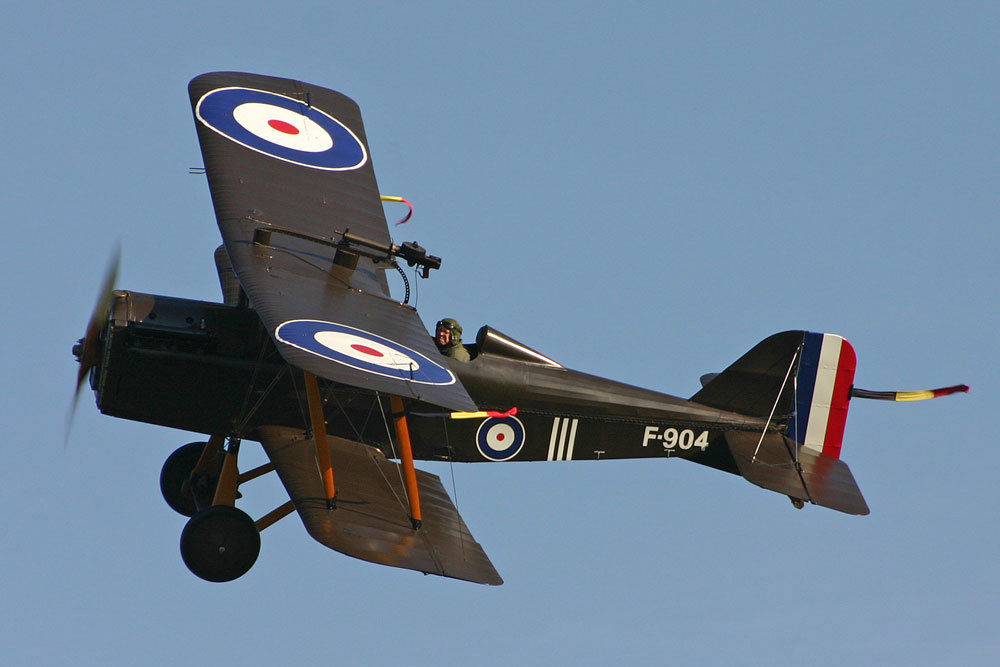
A Royal Aircraft Factory Aircraft Factory S.E.5 of the type flown by Mick Mannock (Wikimedia Commons)
From then on, Mick continued to win aerial battles at a prodigious rate. At the controls of a Royal Aircraft Factory S.E.5 and later a Sopwith Camel, Mick’s tally would rake higher and higher during his time in the air.
By 1918, Mick was commanding RAF No. 85 squadron, composed of many talented airmen, holding the rank of Major. He continued to win victories. Some estimates put Mick’s tally as high as 73 confirmed victories although this continued to be debated. 61 is thought to be the more accurate figure.
Either way, his scores make him the foremost British fighter pilot of World War One.
Unfortunately, Mick would not live to see the end of the war.
On 26th July 1918, Mick offered to help new arrival Lt. Donald C. Inglis obtain his first aerial victory. Together, Kiwi Donald and Mick shot down a pair of German LVG biplanes.
After this, Mick is believed to have dived down to check out the wreckage at the crash site but in doing so crossed over enemy trenches. A massive fusillade of enemy anti-air fire raked Mick’s plane, hitting the engine which then burst into flames.
Mick was thought to have been thrown clear of his damaged plane upon hitting the ground but the exact cause is unknown.
Mick’s body was never recovered. As he has no known grave, Edward “Mick” Mannock is commemorated on the Arras Flying Services Memorial.
Mick was awarded several medals for his exploits including a Military Cross and a Distinguished Service Order with two bars. After vigorous campaigning by his squadron mates, Mick was also posthumously awarded the Victoria Cross in 1919.
Royal Air Force in World War Two

Supermarine Spitfires: perhaps the most iconic RAF aircraft of World War Two (© IWM TR 1020)
For many, the Royal Air Force’s finest hours came during World War Two.
During the inter-war years, the RAF had been scaled back, but with war once again threatening to engulf Europe in the 1930s, a massive expansion of the aerial service took place.
In the public imagination, the Battle of Britain remains the RAF’s defining World War Two moment.
From June to September 1940, the skies over southern Britain were alive with the sound of machine gun chatter and screaming engines as British, Commonwealth, and Allied Nations and German planes duelled for air supremacy.
While the Few, the fighter pilots and aircrews, gain the headlines, the RAF could not achieve victory in the Battle of Britain without the Many. Hundreds of thousands of ground crew, radar operators, medical crews, and support staff kept the pilots flying.
But the story of the RAF goes far beyond Britain.
World War Two was a global conflict. RAF roundel-bearing aircraft flew and fought in skies all around the world: from the deserts of North Africa to the deep blue seas of the Atlantic, Mediterranean, and Pacific, to the steaming jungles of Burma and the Far East.
The Royal Air Force was also supported by the Dominion air forces, such as those from Canada, Australia, South Africa, India, and New Zealand. These men and women played an important role in achieving the Allies’ aerial goals and ultimately achieving total air superiority.
Some branches of the RAF, however, have courted controversy: notably Bomber Command under the command of Air Marshal Sir Arthur Harris.
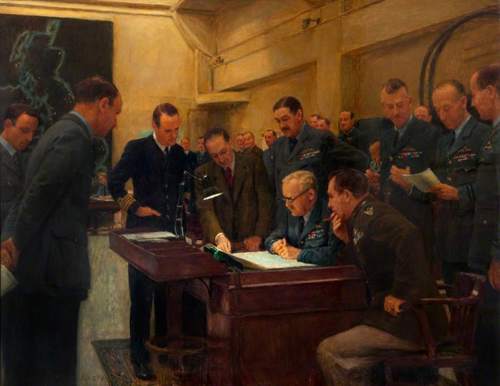 Image: Operations Room Conference, Bomber Command, October 1943, Herbert Arnould Olivier (Wikimedia Commons)
Image: Operations Room Conference, Bomber Command, October 1943, Herbert Arnould Olivier (Wikimedia Commons)
Bomber Command’s policy of area bombing has been controversial in post-war discourse. What isn’t controversial is the incredible courage bomber crews showed during their incredibly dangerous missions.
For extended periods, bomber crews took their aircraft on long sorties over a hostile continent, braving skies laced with deadly flak and anti-aircraft fire, enemy fighters, and terrible conditions.
As a result, Bomber Command’s rate of attrition was massive. Estimates suggest the unit suffered a 44% death rate during World War Two.
The RAF in World War Two was not a strictly British organisation. Pilots and aircrews came from every corner of the globe to serve. Jamaicans, Nigerians, Sierra Leoneans, Canadians, Americans, Polish, Free French, and more nationalities served.
Women also had an important role to play. The Women’s Auxiliary Air Force (WAAF), although not an RAF organisation, worked alongside the Royal Air Force during the war.
Many served as radar operators, plotters, clerks, codebreakers, radio operators, and in other incredibly important non-combat roles. Radar operators were incredibly vital for Britain’s air defence network.
The WAAF reached 180,000 members at its 1943 peak. Over 2,000 women enlisted each week.
The Air Transport Auxiliary was another female unit that served an important wartime function. ATA pilots ferried new, repaired, and damaged aircraft from factories and assembly plants to maintenance hubs, active service squadrons and airfields, transatlantic delivery points, and even aircraft carriers.
RAF Second World War casualties
As the role of the Royal Air Force had expanded significantly, as had the size of the organisation, its World War Two casualties are much higher than those sustained during the Great War.
World War Two RAF casualties totalled around 120,000. This figure includes pilots and aircrews but also incorporates casualties from ground crews, the RAF Infantry Division (instigated to protect airfields from ground assault), and the WAAF.
Of these, the largest proportion of casualties by a single sub-organisation was Bomber Command.
Some 57,000 or so Bomber Command members perished during World War Two. Its rate of attrition was the highest of any unit in the British and Commonwealth forces.
Flying Officer Cyril Joe Barton VC
 Image: Flying Officer Cyril Joe Barton (Wikimedia Commons)
Image: Flying Officer Cyril Joe Barton (Wikimedia Commons)
Few exemplify the dangers faced by Bomber Command airmen and their incredible courage better than Flying Officer Cyril Joe Barton.
Cyril was born in 1921 in Elveden, Suffolk, UK. He had a connection to aircraft at a young age.
At aged 16, Cyril was apprenticed as an engineer at the Parnall Aircraft Factory Works in Tolworth, while also studying engineering part-time.
Despite his work at Parnall being listed as a reserve occupation, i.e., essential to the war effort, Cyril left the factory to join the Royal Air Force Reserve in April 1941.
Cyril then travelled to the United States under the Arnold Scheme to begin his pilot training. He returned to the UK in November 1942 as a fully qualified sergeant pilot.
September 1943 saw Cyril join Bomber Command as part of No. 78 Squadron. He was promoted to Pilot Officer within three weeks of joining his unit.
Cyril flew nine operational sorties over France with No. 78 Squadron until he was transferred to No. 578 Squadron in January 1944. Soon, Cyril was piloting his Handley Page Halifax bomber LK797, dubbed Excalibur by her crew, on raids over Germany, including missions targeting Stuttgart and Berlin.
30th March 1944.
Cyril and the crew of Excalibur are taking part in the large bomber raid on the city of Nuremberg in Southeast Germany.
Some 70 miles from the target, two Luftwaffe night fighters came screaming out of the dark, guns blazing, Excalibur in their sights.
The lumbering Halifax bomber was badly hit:
- Two of her fuel tanks were punctured
- Her radio was disabled
- The rear turret gun was taken out of action
- Starboard inner engine was critically damaged
- Internal intercom lines were hit
Cyril was now an engine down, had no means of communicating with home or other aircraft, and was running on limited internal communications too.

A Handley Page Halifax Bomber. Cyril Joe Barton's Excalibur was one of these aircraft (Wikimedia Commons)
Despite determined, persistent attacks from his German opponents, Cyril, in a running battle, managed to throw off and escape his pursuers – no mean feat in a bulky, slow aircraft squaring off against two nimble fighter planes.
An onboard misunderstanding resulted in three of Excalibur’s seven-man crew bailing out. Cyril was left with no navigator, bombardier, or radio operator.
Rather than turn and head back to England, Cyril pressed on. He nursed the wounded Excalibur to the target zone and dropped his payload.
Just as Cyril turned Excalibur to begin the sojourn home, her starboard engine blew up.
It took four-and-a-half hours for Cyril and his ailing aircraft to make it back to the English coast. All the while, Excalibur was leaking fuel and an engine down. Cyril also had no navigational aids and still had to traverse hostile airspace out of Germany and occupied Europe.
Cyril managed to reach the English coast at Dawn, some 90 miles north of his base at RAF Burn in North Yorkshire.
With Excalibur running one engine on fuel vapours, and the altitude too low for the remaining crew to parachute to safety, Cyril decided to perform an emergency landing.
Excalibur crashed in the village of mining Rhyhope. Cyril managed to steer his craft away from the pit head equipment and cottages to crash land outside of the village proper.
The three remaining crew members Cyril was carrying all managed to survive the ordeal. Cyril was not so lucky.
While he was alive when pulled from the wrecked Excalibur, Cyril succumbed to his injuries just before he reached hospital. He was just 22 years old.
For his courage, dedication to the mission, and safeguarding of his crew, Cyril was posthumously awarded the Victoria Cross.
Flight Officer Cyril Joe Barton is buried in Kingston-upon-Thames Cemetery.
Commonwealth War Graves memorials to the RAF
Commemoration and remembrance of RAF personnel are integral to what we do at the Commonwealth War Graves Commission.
Although RAF personnel can be found in cemeteries or commemorated on memorials all over the world, we have three main sites dedicated to air service personnel.
Due to the nature of their service, aircrews that fell in active service often have no known grave or died in locations where it is impractical or impossible to locate them.
These casualties are commemorated on our air forces memorials.

Runnymede Memorial
The Runnymede Memorial is our largest memorial to missing air force men and women.
Over 20,000 names adorn its memorial panels, commemorating those lost on operations at home in the UK or throughout North and Western Europe.
Representing the scope of the RAF, you will find nationalities from around the world at Runnymede. Personnel from the UK, Australia, Canada, New Zealand, South Africa, India and more are commemorated here.
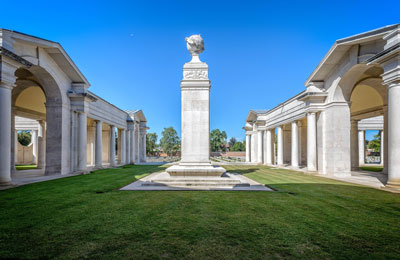
Arras Flying Services Memorial
1,000 air force personnel of the Great War are commemorated on the Arras Flying Services Memorial.
As well as the RAF, those who served in the RNAS and RFC are commemorated here, alongside their comrades in arms from the Australian Flying Corps.
Attrition was high for air services from the outset of World War One. Tactics and aircraft developed at a breakneck pace. When one side gained an advantage, it showed in the number of victories won and losses inflicted.
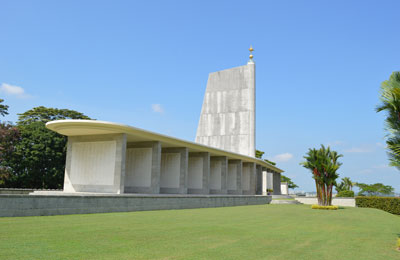
Singapore Memorial
Look closely at the design of the Singapore Memorial and you’ll see its aviation inspiration. Its low roof and jutting central feature resemble the wings and tail fin of a World War Two fighter.
Over 24,000 Commonwealth men and women are commemorated upon the memorial. 3,000 are Royal Air Force personnel.
The air war in the Far East saw the RAF’s old, obsolete aircraft outmanoeuvred and outgunned by the fearsome Japanese Zero. As the war progressed, and with deliveries of new aircraft, the Royal Air Force was able to turn the tide and achieve victory in the skies over Asia.
Discover the stories of the RAF’s war dead
The stories of the men and women of the flying services are waiting for you to discover them. You can do that with our Find War Dead tool.
You can search by name, regiment, rank and many more metrics to help refine your search.
Want to know where they’re buried or want to visit one of our sites? Use our Find War Memorials and Cemeteries search tool to find a site to suit you.

